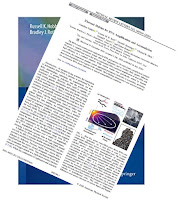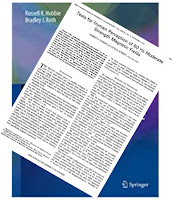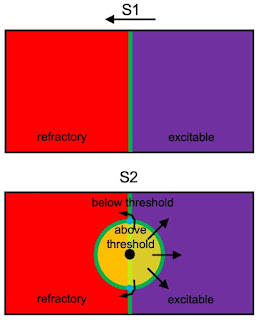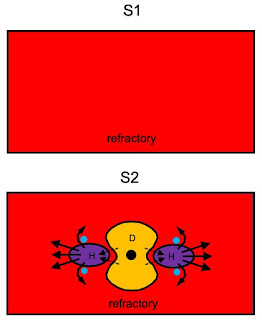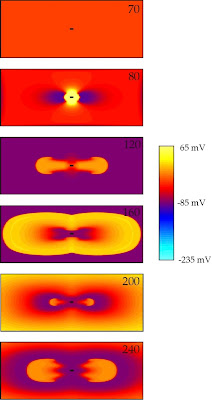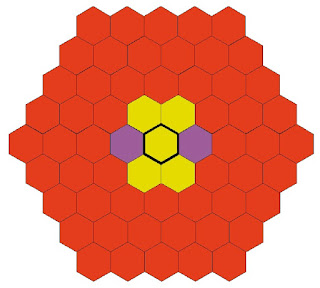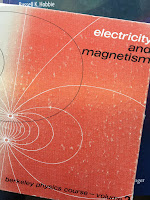“The metric system is officially called the SI system (systeme internationale). It used to be called the MKS (meter kilogram second) system.”
In 2018, the International Bureau of Weights and Measures changed how the seven SI base units are defined. They are now based on seven defining constants. This change is summarized in the SI logo.
 |
| The SI logo, produced by the International Bureau of Weights and Measures. |
First let’s see where the seven base units appear in IPMB. Then we’ll examine the seven defining constants.
Now we examine the seven constants that define these units.kilogram
The most basic units of the SI system are so familiar that Russ and I don’t bother defining them. The kilogram (mass, kg) appears throughout IPMB, but especially in Chapter 1, where density plays a major role in our analysis of fluid dynamics.
meter
We define the meter (distance, m) in Chapter 1 when discussing distances and scales: “The basic unit of length in the metric system is the meter (m): about the height of a 3-year-old child.” Both the meter and the kilogram are critical when discussing scaling in Chapter 2.
second
The second (time, s) is another unit that’s so basic Russ and I take it for granted. It plays a particularly large role in Chapter 10 when discussing nonlinear dynamics.
ampere
The SI system becomes more complicated when you add electrical units. IPMB defines the ampere (electrical current, A) in Section 6.8 about current and Ohm’s law: “The units of the current are C s−1 [C is the unit of charge, a coulomb] or amperes (A) (sometimes called amps).”
kelvin
The unit for absolute temperature—the kelvin (temperature, K)—plays a central role in Chapter 3 of IPMB, when describing thermodynamics.
mole
The mole (number of molecules, mol) appears in Chapter 3 when relating microscopic quantities (Boltzmann’s constant, elementary charge) to macroscopic quantities (the gas constant, the Faraday). John Wikswo and I have introduced a name for a mole of differential equations (the leibniz), but the International Bureau of Weights and Measures inexplicably did not add it to their logo.
candela
Russ and I introduce the candela (luminous intensity, cd) in Section 14.12 of IPMB, when comparing radiometry to photometry: “The number of lumens per steradian is the luminous intensity, in lm sr−1. The lumen per steradian is also called the candela.” The steradian (the unit of solid angle) used to play a more central role in the SI system, but appears to have been demoted.
You can learn more about the SI units and constants in the International Bureau of Weights and Measures’ SI brochure. I’m fond of the SI logo, which reminds me of the circle of fifths. If you’re new to the metric systems, you might want to paste the logo into your copy of Intermediate Physics for Medicine and Biology; I suggest placing it in the white space on page 1, just above Table 1.1.Planck’s constant
In IPMB, the main role of Planck’s constant (h, 6.626 × 10−34 J s) is to relate the frequency and energy of a photon. Quantum mechanics doesn’t play a major role in IPMB, so Planck’s constant appears less often than you might expect.
speed of light
Like quantum mechanics, relativity does not take center stage in IPMB, so the speed of light (c, 2.998 × 108 m s−1) appears rarely. We use it in Chapter 14 when relating the frequency of light to its wavelength, and in Chapter 17 when relating the mass of an elementary particle to its energy.
cesium hyperfine frequency
The cesium hyperfine frequency (Δν, 9.192 × 109 Hz) defines the second. It never appears in IPMB. Why cesium? Why this particular atomic transition? I don’t know.
elementary charge
The elementary charge (e, 1.602 × 10−19 C) is used throughout IPMB, but is particularly important in Chapter 6 about bioelectricity.
Boltzmann’s constant
Boltzmann’s constant (kB, 1.381 × 10−23 J K−1) appears primarily in Chapter 3 of IPMB, but also anytime Russ and I mention the Boltzmann factor.
Avogadro’s number
Like Boltzmann’s constant, Avogadro’s number (NA, 6.022 × 1023 mol−1) shows up first in Chapter 3.
luminous efficacy
The luminous efficacy (Kcd, 683 lm W−1) appears in Chapter 14 of IPMB: “The ratio Pv/P at 555 nm is the luminous efficacy for photopic vision, Km = 683 lm W−1.” I find this constant to be different from all the others. It’s a prime number specified to only three digits. Suppose a society of intelligent beings evolved on another planet. Their physicists would probably measure a set of constants similar to ours, and once we figured out how to convert units we would get the same values for six of the constants. The luminous efficacy, however, would depend on the physiology of their eyes (assuming they even have eyes). Perhaps I make too much about this. Perhaps the luminous efficacy merely defines the candela, just as Avogardo’s number defines the mole and Boltzmann’s constant defines the kelvin. Still, to me it has a different feel.
 |
| Page 1 of Intermediate Physics for Medicine and Biology, with the SI Logo added at the top. |
